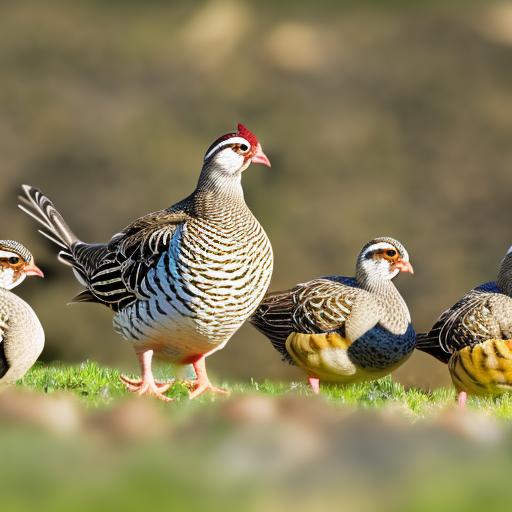Keeping quails and chickens together can be a rewarding experience for poultry enthusiasts. Both quails and chickens are popular choices for backyard farming due to their small size, low maintenance, and ability to provide eggs and meat. While they have different needs and behaviors, with proper planning and management, it is possible to create a harmonious environment where quails and chickens can coexist. In this article, we will explore the benefits of keeping quails near chickens, how to create a suitable habitat for both species, managing feeding and nutrition, addressing potential health and safety concerns, integrating them in the same environment, and tips for successful coexistence.
Key Takeaways
- Keeping quails and chickens together can be beneficial for both species
- Benefits of keeping quails near chickens include pest control and social interaction
- Creating a suitable habitat involves providing separate areas for nesting and dust bathing
- Managing feeding and nutrition requires a balanced diet for both quails and chickens
- Addressing potential health and safety concerns involves regular monitoring and providing adequate space for both species
Understanding the Benefits of Keeping Quails Near Chickens
There are several benefits to keeping quails near chickens. One of the main advantages is the efficient use of space. Quails are smaller in size compared to chickens, so they require less space for housing and roaming. By keeping them together, you can maximize the use of your backyard or farm area. Additionally, quails and chickens have different foraging behaviors, which means they can complement each other in finding food. Quails are ground-dwelling birds that prefer to forage for insects and seeds in low vegetation, while chickens are more adept at scratching and pecking for food on the ground. This can help reduce competition for food resources and create a more balanced ecosystem within the poultry environment. Furthermore, having both quails and chickens can provide a diverse range of eggs for consumption, as quail eggs are smaller and have a unique flavor compared to chicken eggs.
Creating a Suitable Habitat for Quails and Chickens
When creating a suitable habitat for quails and chickens, it is important to consider their specific needs and behaviors. Both species require a secure and predator-proof coop or housing to protect them from potential threats such as predators and harsh weather conditions. For quails, it is essential to provide them with low roosting areas and hiding spots, as they are ground-dwelling birds that prefer to stay close to the ground. Chickens, on the other hand, require elevated roosting areas and nesting boxes for laying eggs. When designing the habitat, it is important to provide separate areas for nesting, feeding, and roosting to minimize potential conflicts between quails and chickens. Additionally, providing ample space for both species to roam and forage is crucial for their physical and mental well-being. Ensuring that the habitat is well-ventilated, clean, and free from moisture will also contribute to the overall health of quails and chickens.
Managing Feeding and Nutrition for Quails and Chickens
Managing feeding and nutrition for quails and chickens requires careful consideration of their dietary requirements. While both species can consume a similar diet consisting of commercial poultry feed, it is important to provide separate feeding areas to prevent competition and aggression during feeding time. Quails have specific dietary needs that differ from chickens, such as requiring higher protein levels in their diet to support egg production. Therefore, it is essential to provide quails with a specialized game bird feed that meets their nutritional requirements. Additionally, offering supplemental sources of calcium, such as crushed oyster shells or limestone, is crucial for both quails and chickens to support strong eggshell formation. Providing access to fresh water at all times is also essential for both species to maintain proper hydration and overall health.
Addressing Potential Health and Safety Concerns
Addressing potential health and safety concerns is crucial when keeping quails and chickens together. One of the main concerns is the risk of disease transmission between the two species. It is important to practice good biosecurity measures, such as regularly cleaning and disinfecting the coop, monitoring for signs of illness, and quarantining new birds before introducing them to the existing flock. Additionally, providing adequate space and ventilation in the coop can help reduce the risk of respiratory diseases. Another concern is the potential for aggression and bullying between quails and chickens. To minimize this risk, it is important to provide ample space, hiding spots, and separate areas for feeding and nesting to reduce competition and territorial behavior. Ensuring that the habitat is predator-proof will also help protect quails and chickens from potential threats.
Integrating Quails and Chickens in the Same Environment

Integrating quails and chickens in the same environment requires careful planning and gradual introduction to minimize stress and potential conflicts. When introducing new birds to an existing flock, it is important to observe their behavior closely and intervene if any aggression occurs. Providing multiple feeding and watering stations can help reduce competition for resources and minimize potential conflicts. Additionally, allowing supervised free-ranging time in a controlled environment can help quails and chickens become familiar with each other without feeling threatened. It is important to monitor their interactions closely during the integration process and be prepared to separate them if necessary. With patience and proper management, quails and chickens can coexist peacefully in the same environment.
Conclusion and Tips for Successful Coexistence of Quails and Chickens
In conclusion, keeping quails and chickens together can be a rewarding experience that offers several benefits, including efficient use of space, complementary foraging behaviors, and a diverse range of eggs for consumption. When creating a suitable habitat for both species, it is important to consider their specific needs and behaviors to ensure their well-being. Managing feeding and nutrition requires careful consideration of their dietary requirements, while addressing potential health and safety concerns is crucial for maintaining a healthy flock. Integrating quails and chickens in the same environment requires patience, observation, and gradual introduction to minimize potential conflicts. By following these tips and guidelines, poultry enthusiasts can successfully coexist quails and chickens in the same environment while enjoying the benefits of both species.
If you’re considering keeping quails near chickens, it’s important to understand the dynamics of raising different poultry species together. One helpful resource to explore is an article on “When Do Guinea Fowl Lay Eggs” from Poultry Wizard. This article provides valuable insights into the breeding and egg-laying patterns of guinea fowl, which can be beneficial for poultry enthusiasts looking to diversify their flock. Understanding the behaviors and needs of various poultry species, such as guinea fowl, ducks, and chickens, can help you create a harmonious environment for your birds. For more information on creating a suitable coop for your chickens, check out the article on “Chicken Coop Chester SC” also available on Poultry Wizard.
FAQs
What are the benefits of keeping quails near chickens?
Quails can help control pests in the chicken coop, such as ticks and mites. They also provide additional eggs and can help with waste management by eating leftover food and insects.
Are there any potential drawbacks to keeping quails near chickens?
Quails may be more susceptible to diseases carried by chickens, and there is a risk of cross-contamination. Additionally, quails may be more skittish and easily stressed by the presence of chickens.
What should be considered when housing quails and chickens together?
It’s important to provide separate housing for quails and chickens to prevent aggression and ensure that each species has access to their specific needs, such as dust baths for chickens and ground cover for quails.
How can I introduce quails to an existing chicken flock?
Quails should be introduced to the chicken flock gradually, allowing them to become familiar with each other’s presence before allowing direct interaction. It’s important to monitor for any signs of aggression or stress during the introduction process.
What should I feed quails and chickens when they are housed together?
Quails and chickens have different dietary needs, so it’s important to provide separate feed for each species. Quails require a higher protein diet, while chickens require a balanced diet that includes grains and greens.
Are there any legal or regulatory considerations for keeping quails near chickens?
It’s important to check local regulations and zoning laws to ensure that keeping quails and chickens together is allowed in your area. Additionally, it’s important to follow any biosecurity measures to prevent the spread of diseases between the two species.
Meet Walter, the feathered-friend fanatic of Florida! Nestled in the sunshine state, Walter struts through life with his feathered companions, clucking his way to happiness. With a coop that’s fancier than a five-star hotel, he’s the Don Juan of the chicken world. When he’s not teaching his hens to do the cha-cha, you’ll find him in a heated debate with his prized rooster, Sir Clucks-a-Lot. Walter’s poultry passion is no yolk; he’s the sunny-side-up guy you never knew you needed in your flock of friends!







